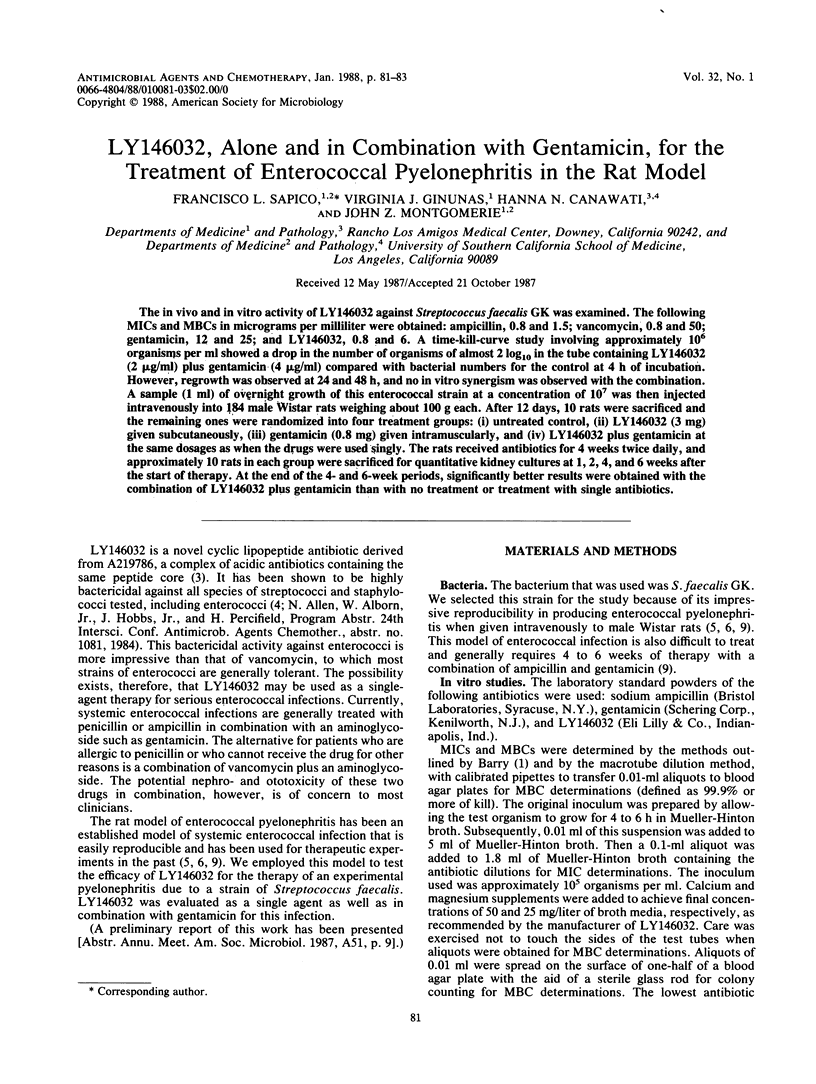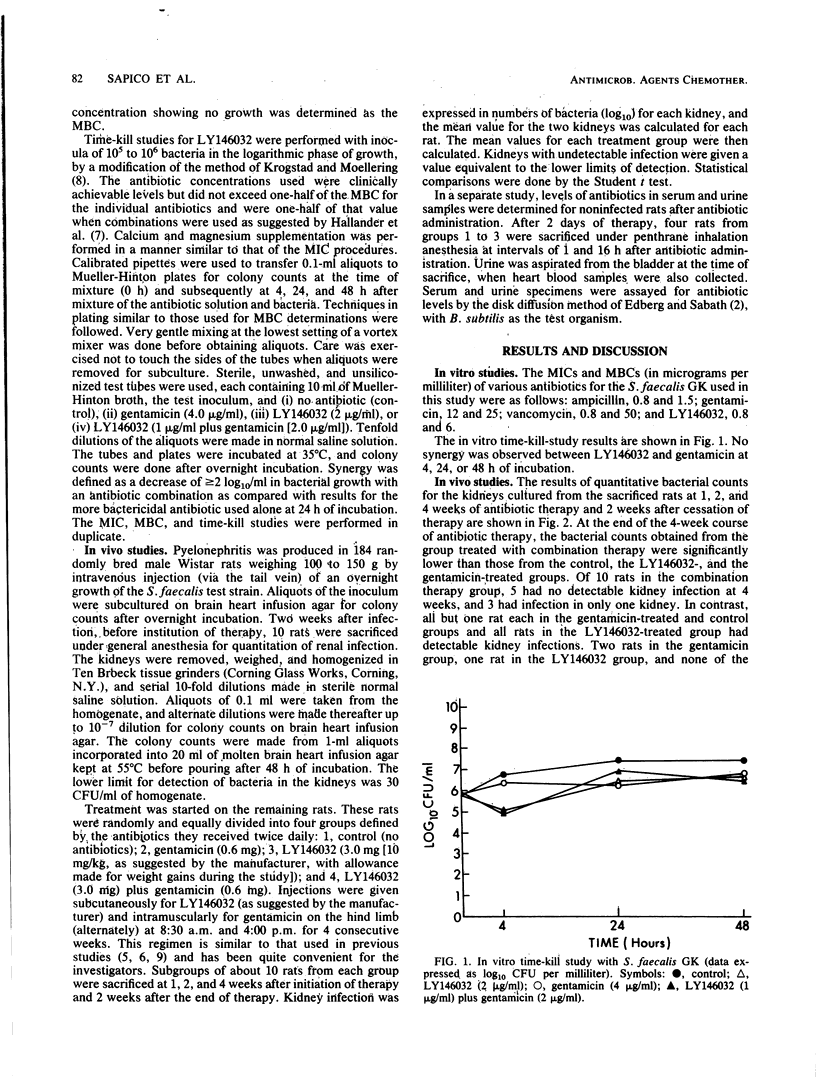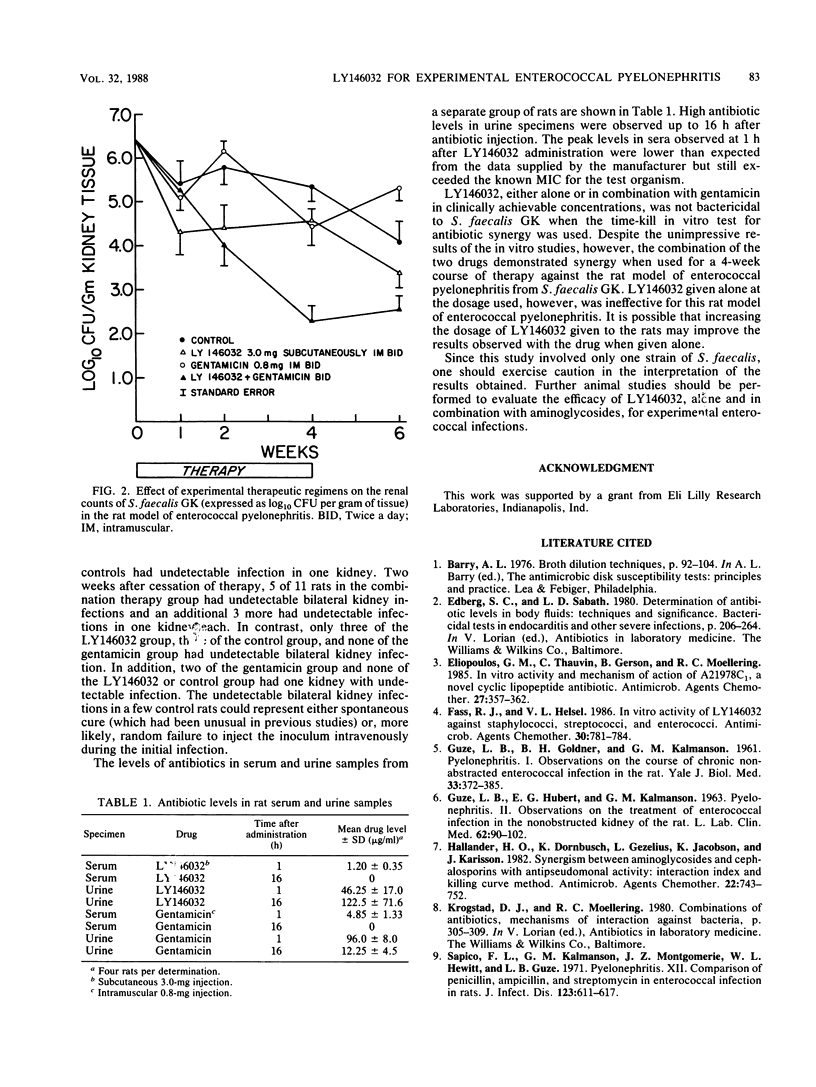Abstract
The in vivo and in vitro activity of LY146032 against Streptococcus faecalis GK was examined. The following MICs and MBCs in micrograms per milliliter were obtained: ampicillin, 0.8 and 1.5; vancomycin, 0.8 and 50; gentamicin, 12 and 25; and LY146032, 0.8 and 6. A time-kill-curve study involving approximately 10(6) organisms per ml showed a drop in the number of organisms of almost 2 log10 in the tube containing LY146032 (2 micrograms/ml) plus gentamicin (4 micrograms/ml) compared with bacterial numbers for the control at 4 h of incubation. However, regrowth was observed at 24 and 48 h, and no in vitro synergism was observed with the combination. A sample (1 ml) of overnight growth of this enterococcal strain at a concentration of 10(7) was then injected intravenously into 184 male Wistar rats weighing about 100 g each. After 12 days, 10 rats were sacrificed and the remaining ones were randomized into four treatment groups: (i) untreated control, (ii) LY146032 (3 mg) given subcutaneously, (iii) gentamicin (0.8 mg) given intramuscularly, and (iv) LY146032 plus gentamicin at the same dosages as when the drugs were used singly. The rats received antibiotics for 4 weeks twice daily, and approximately 10 rats in each group were sacrificed for quantitative kidney cultures at 1, 2, 4, and 6 weeks after the start of therapy. At the end of the 4- and 6-week periods, significantly better results were obtained with the combination of LY146032 plus gentamicin than with no treatment or treatment with single antibiotics.
Full text
PDF


Selected References
These references are in PubMed. This may not be the complete list of references from this article.
- Eliopoulos G. M., Thauvin C., Gerson B., Moellering R. C., Jr In vitro activity and mechanism of action of A21978C1, a novel cyclic lipopeptide antibiotic. Antimicrob Agents Chemother. 1985 Mar;27(3):357–362. doi: 10.1128/aac.27.3.357. [DOI] [PMC free article] [PubMed] [Google Scholar]
- Fass R. J., Helsel V. L. In vitro activity of LY146032 against staphylococci, streptococci, and enterococci. Antimicrob Agents Chemother. 1986 Nov;30(5):781–784. doi: 10.1128/aac.30.5.781. [DOI] [PMC free article] [PubMed] [Google Scholar]
- GUZE L. B., GOLDNER B. H., KALMANSON G. M. Pyelonephritis. I. Observations on the course of chronic non-obstructed enterococcal infection in the kidnev of the rat. Yale J Biol Med. 1961 Apr;33:372–385. [PMC free article] [PubMed] [Google Scholar]
- GUZE L. B., HUBERT E. G., KALMANSON G. M. Pyelonephritis. II. Observations on the treatment of enterococcal infection in the nonobstructed kidney of the rat. J Lab Clin Med. 1963 Jul;62:90–102. [PubMed] [Google Scholar]
- Hallander H. O., Dornbusch K., Gezelius L., Jacobson K., Karlsson I. Synergism between aminoglycosides and cephalosporins with antipseudomonal activity: interaction index and killing curve method. Antimicrob Agents Chemother. 1982 Nov;22(5):743–752. doi: 10.1128/aac.22.5.743. [DOI] [PMC free article] [PubMed] [Google Scholar]
- Sapico F. L., Kalmanson G. M., Montgomerie J. Z., Hewitt W. L., Guze L. B. Pyelonephritis. XII. Comparison of penicillin, ampicillin, and streptomycin in enterococcal infection in rats. J Infect Dis. 1971 Jun;123(6):611–617. doi: 10.1093/infdis/123.6.611. [DOI] [PubMed] [Google Scholar]


